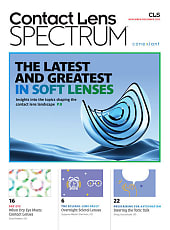Benzalkonium chloride (BAK)-containing glaucoma drops offer antimicrobial effects, an extended shelf life, and facilitate medication instillation in glaucoma patients who lose their ability to use vials. All these characteristics make them an important part of our antiglaucoma medication arma-mentarium. BAK-containing drops can also induce or worsen dry eye disease (DED), which can cause patient nonadherence to these medications, increasing the possibility of irreversible vision loss. In fact, Wolfram et al found that nonadherence is nearly 3 times higher in patients using preserved vs preservative-free drops.1 Here, I discuss the seriousness of this link and how optometrists could circumvent it.

Seriousness of Link
Each additional BAK-containing drop doubles the odds of corneal or conjunctival staining.2 That staining is clinical evidence of chronic inflammation, tear film instability, and epithelial toxicity. Additionally, long-term exposure to BAK-containing glaucoma medications leads to meibomian gland blockage, dropout, and dysfunction.3
Affected patients may not always articulate their discomfort, but the signs are there. These signs include punctate keratitis, hyperemia, fluctuating vision, and lid margin telangiectasia.
Circumventing the Link
To preclude DED caused by glaucoma medications, I think we should change our mindset from prescribing selective laser trabeculoplasty to patients who “fail” drops to prescribing it as a first-line treatment for those who would be better served by switching therapy altogether. An example of such a patient: one who already has the DED diagnosis.
Elevating Decision-Making
I don’t think this approach promotes abandoning medical therapy. Instead, I think it elevates our decision-making, as we are weighing the long-term ocular surface consequences of our treatment plans. Every drop counts. And for our glaucoma patients, many of whom are already dealing with complex regimens, aging tear films, and lid margin disease, that drop may be the difference between success and failure. It may also be the difference between preserved vision and preserved comfort. Treating DED better helps us to treat glaucoma better. OM
References
1. Wolfram C, Stahlberg E, Pfeiffer N. Patient-reported nonadherence with glaucoma therapy. J Ocul Pharmacol Ther. 2019;35(4):223-228. doi:10.1089/jop.2018.0134.
2. Leung EW, Medeiros FA, Weinreb RN. Prevalence of ocular surface disease in glaucoma patients. J Glaucoma. 2008;17(5):350-355. doi:10.1097/IJG.0b013e31815c5f4f.
3. Arita R, Itoh K, Maeda S, et al. Comparison of the long-term effects of various topical anti-
glaucoma medications on meibomian glands. Cornea. 2012;31(11):1229-1234. doi:10.1097/ICO.0b013e31823f8e7d.




